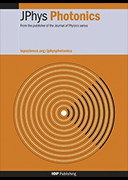Description
About the journal
- Scope
- Why should you publish in JPhys Photonics?
- Article types
- Special requirements
- Peer review
- Ethics
- Open access information
- Research data
- Copyright and permissions
- Abstracted in
Scope
JPhys Photonics will showcase the most significant and exciting developments in the science, technology and application of photonics. Research is increasingly a collaborative enterprise, breaking traditional subject boundaries, and JPhys Photonics will reflect this by focusing particularly on interdisciplinary and multidisciplinary research. JPhys Photonics welcomes submissions from all disciplines, including physics, chemistry, engineering, biology, medicine and related fields, and aims to facilitate the flow of knowledge between and beyond these communities, ensuring authors gain maximum impact and visibility for their work. The journal represents a community-oriented approach to communicating science driven by the needs of scientists rather than funders, institutions or for-profit corporations.
All photonics-related and photonics-enabled research is in scope, especially interdisciplinary and multidisciplinary studies. Subjects covered will include, but not be restricted to, the following areas:
Fundamentals and technologies
- Fibre optics and waveguides
- Light sources
- Light-matter interactions
- Nanophotonics
- Nonlinear and ultrafast optics
- Optical imaging and non-imaging components
- Optoelectronics, semiconductor photonics and photonic integrated circuits
- Photonic materials, metamaterials and engineered structures
- Plasmonics
- Propagation, interaction and behaviour
- Quantum photonics
Applications
- Advanced manufacturing and robotics
- Advanced materials and smart structures
- Art and archaeology
- Biomedical and biotechnology
- Computing and data storage
- Data communication and the Internet of Things
- Energy, green technology and the circular economy
- Food and health
- Imaging, detection and sensing
- Light, illumination, detection and imaging
- Optical communications and fibre optics
- Optical data storage
- Quantum cryptography and quantum computing
- Security, identification and cryptography
- Sensing and authentication
- Spectroscopy and microscopy
- Textiles and wearables
- Therapeutics, optogenetics and neurophotonics
- Vehicles and aerospace
- Visualization and virtual/augmented reality
Why should you publish in JPhys Photonics?
- High standards: JPhys Photonics selects the most significant and cutting-edge research being undertaken in the field of photonics. Articles are rigorously peer reviewed by IOP Publishing’s global network of expert referees, supported by our top-level editorial board.
- Fast publication: we are committed to providing you with a fast, professional service to ensure rapid first decision, acceptance and publication. Once accepted, your article will be accessible to readers within 24 hours and will include a citable DOI.
- Open access: immediate and perpetual open access to your research under a CC-BY licence so that it can be accessed and shared by anyone without restriction.
- Inclusive: with a scope covering interdisciplinary studies and multidisciplinary collaborations as well as traditional disciplines, JPhys Photonics brings together photonics researchers from all disciplines.
- Transfer opportunities: as well as accepting direct submissions, the journal also offers you a quick and easy solution to transfer your manuscript from another IOP Publishing journal if it does not fit the scope or significance criteria of JPhys Photonics. Articles are transferred along with peer review reports to save time and avoid duplication of work for referees.
- Society owned: IOP Publishing is a leading society publisher of advanced physics research. Any profits generated by IOP Publishing are invested in the Institute of Physics, helping to support research, education and outreach around the world.

